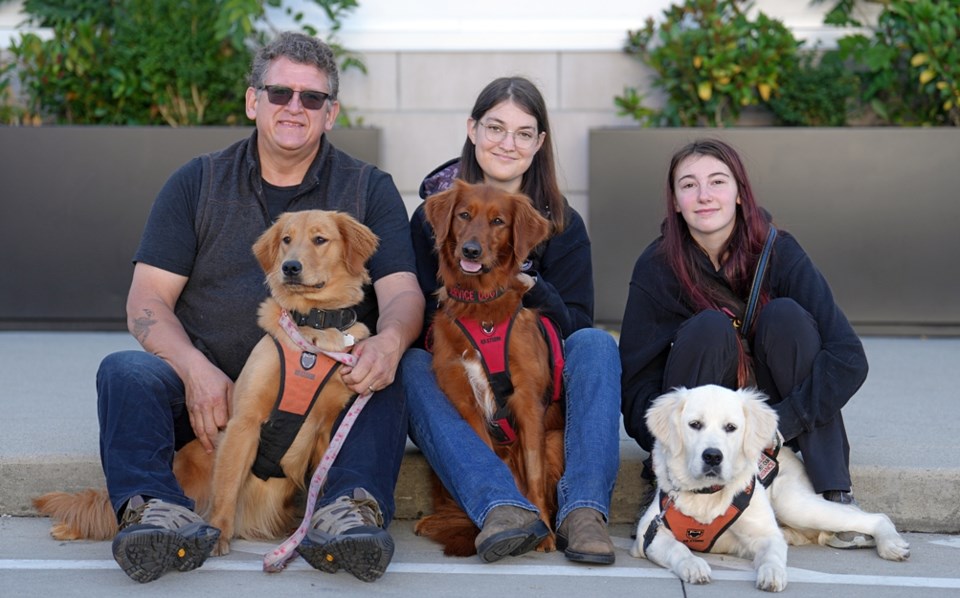A dog trainer says a recent incident is a reminder that working service and guide dogs should not be petted, played with or even praised because it can interfere with the job they’re trained to do — and even put their owners at risk.
Tyson King, who operates VI K9, a non-profit society that trains dogs to assist owners with various disabilities, said the incident happened recently at a Greater Victoria shopping centre.
A trainer from VI K9 was working with a golden retriever trained in medical alerts and a new client who often suffers from seizures at the mall.
The client actually had a seizure in the shopping centre’s corridors while sitting on a sofa. King said the dog responded by getting on top of the woman in distress, putting paws on each side of her body and applying its weight to stabilize her movements, a move he described as “compressions.
“Those compressions by the dog were all correct behaviour for the dog,” said King.
But at that point, a member of the public decided to engage with the dog, he said. “He was saying he was a good boy and was trying to pet him, which is exactly what the public should not do.”
King said the trainer attempted to get the man to move away to no avail, and the trainer had to speak “loudly and strongly” to make the man understand.
A mall employee intervened on behalf of the shopper, said King, “and the situation become confrontational.” King, who had to be called in to deal with the incident, said it could have been avoided.
“I think the public has to realize that a service dog is trained to react for its owner. It can’t be distracted.”
He said anyone who comes upon a similar incident should clear the area, calmly ask if assistance is required, and call 911 for medical attention if needed.
King said medical alert service dogs can identify if their owners are having seizures and even sense them coming on, and will act according to how they are trained — in this case by stabilizing what could be erratic movements, or in other situations by barking loudly to raise the alarm.
King, a veteran who served in conflicts overseas, said his company uses his experiences with post-traumatic stress disorder and service-dog training skills to bring those who need a service dog together with the dogs who can help them in daily life.
The dogs are trained for various disabilities, including PTSD, autism, diabetes and seizure detection as well as physical and hearing assistance.
King said medical alert dogs can be trained to attend their handlers in the event of a diabetic or epilepsy episode. Some of the dogs may have instructions on their collars directing responders to medications like an EpiPen.
Autism assistance dogs can have a calming influence, said King, while others can work with a handler who suffers from anxiety attacks or post-traumatic stress disorder. “These dogs are trained never to leave their handler’s side,” he said.
Dogs’ uncanny sense of smell can also help detect life-threatening allergens like even the slightest trace of peanuts, said King.
The CNIB Foundation, which uses guide dogs to assist the blind, deaf-blind and those with low vision, has long promoted the proper public etiquette around the animals.
Guide dogs are not pets, says the CNIB, which calls the animals partners in mobility.
“Although guide dogs are among the most highly trained dogs in the world, they’re still dogs. And distracting them while they’re working can jeopardize both their safety and the handler’s,” it says.
So, how should you behave around these dogs?
First off, the CNIB says to remember that a guide dog’s number one priority is the safety of their handler.
It offers these guidelines:
Harness on means hands off
A guide dog in a harness means “Please don’t interact with me. I’m working.” As tempting as it may be, never pet, talk to, or make eye contact with a guide dog in a harness.
Contain your excitement
Don’t encourage excitable play with a guide dog. Staying calm is part of the job and excitement directed toward them is distracting.
Say “hello” another time. If you approach a guide dog team with your pet dog, keep your dog on a leash and away from the guide dog.
Hands off and no treats
Never grab a guide dog’s harness or leash, or try to steer their handler. This can be disorientating and dangerous for the guide dog and the handler.
Never offer food or treats to a guide dog. This can result in disruptive behaviours like begging for food and scavenging off the ground.
It’s OK to offer help
Before offering your assistance, you should always ask if it’s needed. When approaching a guide dog handler, introduce yourself and always speak directly to the handler, not the guide dog.
Educate and advocate
Help champion equal access for guide dog teams. If you encounter someone not following proper guide dog etiquette, politely remind them not to distract the guide dog.
>>> To comment on this article, write a letter to the editor: [email protected]



